Prince Albertís Visit to Loch Lomond
The first of the modern royal visits to Loch Lomond was in August 1849 as Queen Victoria and Prince Albert were making their way to Balmoral, which they did not as yet own, for a summer holiday. The journey to Scotland was preceded by an official visit to Ireland where the royal couple made official visits to Cork, Dublin and Belfast, travelling between these cities on the Royal Yacht. Ireland has now been more or less written out of Queen Victoria’s biographies, but for many years in the early part of her reign Victoria had a great affinity with Ireland and although she holidayed at Balmoral from 1848 onwards and Albert bought the estate in 1852, it was possible after her visit to Killarney in 1861 that she might have added a holiday home in Killarney to that of Balmoral, giving her a choice of holiday destinations on the Celtic Fringes. However, a combination of the deteriorating political situation in Ireland and Prince Albert’s death a few months after her 1861 visit meant that nothing came of any possible Irish home.
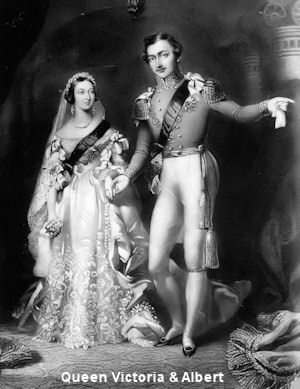 In fact the unrest in Ireland caused by the Irish Famine of 1845-8 was the main reason for the 1849 royal trip to Ireland. The trip was aimed, firstly at repairing some of the damage to the British government’s reputation caused by its incompetent handling of the Famine and secondly at drawing their attention that the effects of the Famine were very much in evidence.
In fact the unrest in Ireland caused by the Irish Famine of 1845-8 was the main reason for the 1849 royal trip to Ireland. The trip was aimed, firstly at repairing some of the damage to the British government’s reputation caused by its incompetent handling of the Famine and secondly at drawing their attention that the effects of the Famine were very much in evidence.
There was a great deal of unrest and violence against the government and the Anglo-Irish in the Irish countryside and towns – hardly surprising as people saw hundreds of thousands of their families and fellow-country folk starve to death. However it was hoped that a visit by the Queen and Prince Albert might help calm things down. Although it was a high-risk strategy, in the event the royal couple were received with unexpected enthusiasm in the two southern cities, without making any impact on the levels of civil unrest in the medium or longer term. As was to be expected, they had as normal a visit in Belfast as they would have had in any other part of Britain even if it lasted only 5 hours.
The one consistently negative aspect of the visit was the bad weather, particularly for the sea-trip parts of the journey. The sail from Dublin to Belfast took place in very stormy and rough seas, which left the Queen sea-sick, while the planned sail from Belfast to Loch Long in Scotland became something of a marathon with the Royal Yacht HMY Victoria and Albert and its accompanying flotilla having to take shelter twice before it had even left Belfast Lough. The Royal Yacht was the first of 3 named Victoria and Albert. She had been launched in 1843 and was a 1,034 ton paddle steamer – the first steam-powered Royal Yacht. Rough and stormy seas were not her metier and the crossing to Scotland also involved seeking shelter on the south-west coast around Loch Ryan.
Official visits had been planned in Scotland, particularly to Glasgow, as part of the couple’s journey north to Balmoral, but it was understood that the arrangements for these visits were “best estimates” and subject to change.
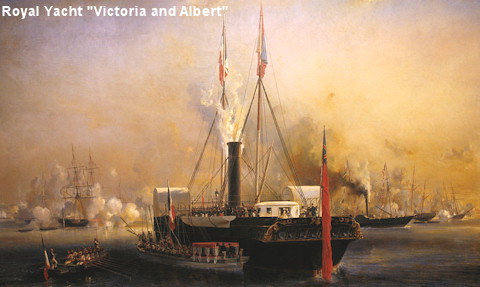 From the outset the plan was that the royal flotilla would not head directly for Glasgow but would probably take the opportunity to cruise the sea lochs of the Firth of Clyde on Sunday 12th August 1849.
From the outset the plan was that the royal flotilla would not head directly for Glasgow but would probably take the opportunity to cruise the sea lochs of the Firth of Clyde on Sunday 12th August 1849.
The Queen and Prince would then disembark at Arrochar on the morning of Monday 13th August 1849, cross over to Tarbet and sail on Loch Lomond heading eventually for Balloch, from where they would take a coach to Dumbarton, travelling through Alexandria and Renton. There they would be picked up by the Royal Yacht tender, HMY Fairy which would take them back to the Royal Yacht for an overnight stay, off Rosneath in the Gareloch, before travelling on to Glasgow on Tuesday 14th August. That was the plan and all the local arrangements were structured round it.
In those days changes to plan were usually caused either by Royal whim – which was not very common when Prince Albert was involved – or by the weather. This was especially true where sea voyages were involved. This was long before radio communications between ships and shore; news of a ship’s whereabouts was communicated either by other ships which had sailed past them or from sightings from land. That only told where a ship was at any point in time, it did not of itself offer hard information about what the ship was going to do next. In the case of the royal flotilla, once it had sailed from Belfast on the afternoon of Saturday 11th August, it took shelter, not once but twice, in Belfast Lough. It stayed at its second anchorage at Carrickfergus on the Saturday night and until between 2 and 3 o’clock on the Sunday afternoon.
It then made the short dash across the North Channel arriving in Loch Ryan about 6 o’clock in the evening. The weather remained so bad that they decided to stay there overnight. It was not until early on the Monday morning that the royal flotilla set off again, heading for the Clyde estuary. Most of the flotilla reached the Tail of the Bank between 10 and 11 o’clock on the Monday morning, but there was no sign of the Royal Yacht from the vantage points in Greenock. In fact it had slipped past unseen in the poor weather and was now making for Loch Goil before finally heading for its intended anchorage at Arrochar.
The plans for the cruise on Loch Lomond called for the Queen to disembark at Arrochar about 10 am. HMY Victoria and Albert did not arrive at the Arrochar anchorage until about mid-day in weather which was described “as very wet and stormy ... February weather with August temperatures.” Whatever happened next, the trip on Loch Lomond was already away behind schedule.
Such hazards were well understood by the members of the Queen’s staff who were ultimately in charge of local arrangements and they had been impressed on the notables who became responsible for arrangements in Arrochar, Tarbet and Balloch. At Arrochar Sir James Colquhoun of Luss was responsible, both as the Lord of the Manor and also as the Lord Lieutenant of the County of Dumbartonshire, for welcoming the royal party onto Scottish soil. At Tarbet it was local landowner Mr James McMurrich who was in charge, while at Balloch the job fell to Mr William Campbell of Tullichewan Castle and Estate as the landowner of the ground on the west bank of the River Leven at Balloch where the Queen would land.
Although an outline plan had been drawn up for handling the royal visitors, it was as late as Saturday 11th August before it was confirmed to the organisers that the Queen would definitely be sailing on Loch Lomond on the Monday 13th. Rather a lot of preparations had then to be carried out over the week-end.
Arrochar
In 1849 Arrochar still had no pier, so the Queen could not step directly from the Royal Yacht onto land but would have to be transferred by royal barge from the ship’s anchorage to shore, a journey of about 100 yards. As it turned out, that short journey changed the nature of the sail on Loch Lomond and visit to Balloch. On the Saturday morning Sir James ordered the building of a landing stage in Loch Long at which the barge would dock and also the construction of an arch at the entrance to the road to Tarbet. This arch consisted of two sticks bound together by an iron rod and covered in heather and evergreen. Altogether four such arches were built to welcome the royals: Tarbet got a bit carried away and two were built on the road down to the pier, while another was put up at Balloch; this one had flowers on it. The royals may well have gone through life thinking that every wayside village and hamlet in Britain sported its own triumphal arch.
Tarbet
Tarbet had a substantial pier, which had been opened in 1846, a few years after the accident which caused the largest loss of life on the Loch – 11 people had drowned in the early 1840’s while transferring between a steamer and the beach at Tarbet. So apart from the construction of a couple of arches, Mr McMurrich hadn’t much to do to prepare for the arrival and departure of Their Majesties at the pier.
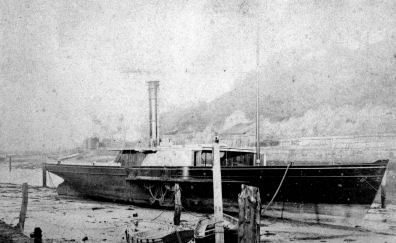 On water, the paddle steamer which awaited the royals at Tarbet Pier and which was to carry them on their cruise of Loch Lomond was the Waterwitch. It was owned by the Lochlomond Steamboat Co who had made it available to the Royal party; in fact it was the only steamer sailing on the Loch that summer, but great prestige attached to it from carrying royal passengers.
On water, the paddle steamer which awaited the royals at Tarbet Pier and which was to carry them on their cruise of Loch Lomond was the Waterwitch. It was owned by the Lochlomond Steamboat Co who had made it available to the Royal party; in fact it was the only steamer sailing on the Loch that summer, but great prestige attached to it from carrying royal passengers.
The Waterwitch had been launched in August 1843 and was regarded as a very fast steamer, which was part of her attraction to the people who bought her to sail on Loch Lomond. When she was introduced onto the Loch in May 1844 her route was Balloch to Inverarnan and back, with an evening trip to Inverarnan and an overnight stay there on two days a week. A cabin deck was soon added for the comfort of passengers. So even if there had been other steamers to choose from, she would probably have been selected to carry the royal passengers. The steamer was completely repainted for the trip and her decks had been carpeted – unfortunately there’s no record of how long the carpeting survived the Loch weather after the royal trip.
(Note: In 1852, it was found that the hull of the Waterwitch was in poor repair and a new hull was built for the machinery of the old vessel which was now named Queen Victoria. The photograph shows her at Whitby, after she left Loch Lomond in 1868 but it is not thought she changed substantially.)
Balloch

The “great and the good”, who were to be presented to the Royal Party, could imbibe, away from the prying eyes of the hoi-polloi, in the Balloch Inn just across the Bridge. The fact that there was no adequate landing stage was easily resolved: just as Sir James Colquhoun set about building one at Arrochar on the Saturday morning, so William Campbell set a team of men to work on building a new landing stage on the west bank of the Leven just to the north of Balloch Bridge.
By lucky chance the ground on which it was built was to feature in the Sweeney case of 1909-1911 and the Rights of Way case of 1913, and we therefore have the testimony of some of the old witnesses in these cases about the building of the landing stage and the Royal visit itself. The most complete account of the building of the landing stage was given by Archibald McIntyre, who was 79 when he gave evidence at the Court of Session in 1913, which meant that he was 15 when he saw the landing stage being built. “That landing stage had been erected on August 14th 1849 (he was a couple of days out on the date, but not bad for a 79 year old recalling the events of 64 years before) and lasted for 16 and a half months. It was put there for the landing of Queen Victoria and Prince Albert. ... The landing stage was not meant to be a permanent structure ... the stage was built of fir trees with the bark on every stick. It cost £5.” For something which was a hastily-built, temporary structure made of rough wood from which the bark had not even been stripped, it lasted pretty well, because its stumps could still be seen well over fifty years later, as this photograph shows.
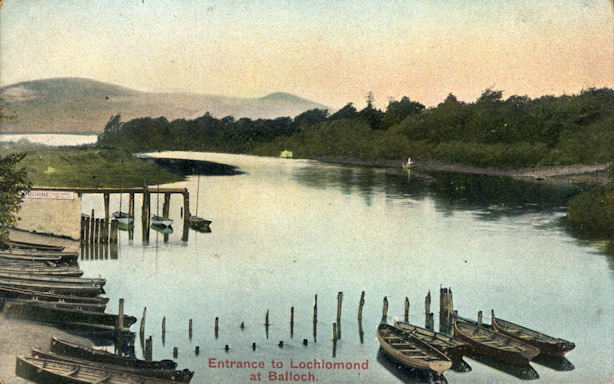
Photo from Balloch Bridge c 1895 with the stumps of the landing stage in mid photo
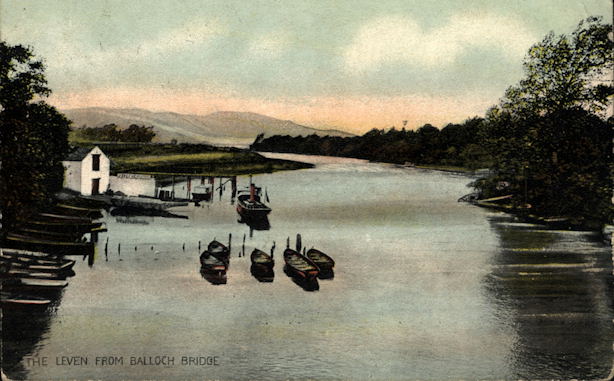
Similar Photo taken about 10 years later with 5 boats tied up to the stumps
The Glasgow Herald of 17th August 1849 adds the following description: “The landing platform was beautifully decorated. It was laid with a carpet of the choicest description, from the verge of pier to the point where the carriage for her Majesty was to be drawn up. A very neat triumphal arch, covered with evergreens and surmounted with a floral crown and other devices was erected for the Royal party to pass under on going from the steamer to the carriages.” It’s a pity that they didn’t actually describe the “choicest description” – apart from anything else was it red?
Building a landing stage in the Leven at Balloch wasn’t the only task which William Campbell was asked to undertake. On Friday afternoon, 10th August, Captain Robinson RN, one of the Royal equerries, called at Tullichewan Castle and asked William to provide carriages to take the Royal Party from Balloch to Dumbarton. He needed carriages in addition to his own to accommodate the whole Royal Party, so he immediately got in touch with Messrs Wylie & Lochhead of Glasgow, who could probably still meet such a request.
So by Saturday morning the planned order of the carriages which would await the Royal Party at the Balloch landing stage was: firstly Mr Campbell’s carriage, richly lined with white silk and drawn by six beautiful horses which would lead the procession; it would be followed by three carriages each drawn by four horses, the postilions all dressed uniformly in the Royal livery. However, a protocol turf war broke out by the Saturday afternoon when Campbell was told that Sir James Colquhoun expected, as Lord Lieutenant of the County, that his carriage should be used by Her Majesty and Prince Albert. Since it already being used to convey the royal pair from Arrochar to Tarbet it had to make a quick dash down the Loch-shore road to be in Balloch on time. William Campbell had, of course, no option but to agree to this change in plan.
The other feature of the preparations at Balloch was the swearing-in of auxiliaries – to-day’s equivalent of special constables - to help the County policemen in controlling the expected crowds. These men were workers at the local bleaching, dyeing and print works and were provided free of charge by the factory owners. Since the visit was taking place on a Monday, it was a day off work for these men, and it would be interesting to know if they were actually paid that day.
The Planned Timetable
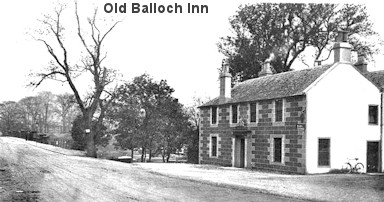 The original plan of the royal tour was for the Royal Yacht to be at her anchorage in time for the Queen to disembark mid-morning on the Monday, cross over to Tarbet and then go for a cruise on the Loch which would terminate at Balloch in the early afternoon. Crowds had gathered at each location in anticipation of that time-table. At Arrochar the local population had gathered from early morning around the landing stage, staring out through the pouring rain at an empty Loch Long.
The original plan of the royal tour was for the Royal Yacht to be at her anchorage in time for the Queen to disembark mid-morning on the Monday, cross over to Tarbet and then go for a cruise on the Loch which would terminate at Balloch in the early afternoon. Crowds had gathered at each location in anticipation of that time-table. At Arrochar the local population had gathered from early morning around the landing stage, staring out through the pouring rain at an empty Loch Long.
At Balloch people started to congregate on the Bridge and at other vantage points as early as 10 o’clock; by 1 o’clock the whole area around the landing stages as well as the Bridge itself was crowded with spectators. The local gentry and their families such as William Campbell of Tullichewan, Alexander Smollett, RD McKenzie of Caldarvan, John and Archibald Orr Ewing, had taken over the Balloch Inn for the day where they took shelter and sustenance while they awaited the royal arrival. As to what was actually happening, no one was any wiser than anyone else whether they were standing out in the rain our sitting comfortably in the warmth of the Inn.
Back at Arrochar
The Royal Yacht dropped anchor about 12.15. No more than 30 minutes later the first attempt was made at disembarking. The royal barge was lowered into the water and the sailors manned the oars ready for the short row to shore. At that precise moment, however, the heavens opened and the rain came down is it can only in Arrochar. The attempt was abandoned for the time being and it was decided to have lunch and try again after that.
So, about 3 o’clock the second attempt was made and this one got a little further than the first. The Queen and Albert actually made it into the royal barge, the Royal Standard was lowered on HMY signifying that Her Majesty had definitely departed the ship, but no sooner had that happened than it started to pour down again, soaking everyone on the barge. The whole party headed back to the HMY Victoria and Albert and the Queen abandoned any further attempts to sail on Loch Lomond.
She had endured 3-4 days of sailing on stormy seas since leaving Dublin with wind, waves and rain a constant feature and sea-sickness never very far away. Loch Lomond could wait for another day. At about 4 o’clock the Royal Yacht weighed anchor and set sail down Loch Long heading for its overnight mooring at Rosneath on the Gareloch. Her progress down the Loch and into the Clyde was accompanied by shore batteries firing salutes, and crowds on specially-chartered steamers cheering the Royal Yacht – the Prince of Wales, later Edward VII, who was still a child, was the only Royal who appeared on the deck and he acknowledged the cheers from the steamers by waving his sou-wester hat.
Prince Albert’s Trip
Prince Albert, however, was not on the Royal Yacht. Being of sterner stuff and no doubt not wanting to let anyone down, he had decided to make the trip on Loch Lomond by himself. Accordingly, he left the Royal Yacht about 3.15 and was taken by Sir James Colquhoun’s coach over to Tarbet Pier. There he boarded the Waterwitch just before 4 o’clock and set out on the trip on Loch Lomond. To provide musical entertainment he was accompanied by the personal piper of William Campbell of Tullichewan and the orchestra from the Prince’s Theatre in Glasgow. That was probably just as well because there wasn’t much to see of the Loch’s famed landscape through the rain and mist. The Ben remained invisible all day and although it is said that the Prince managed to see Rob Roy’s cave north of Inversnaid, he wouldn’t have seen a great deal more on a dreich Loch day.
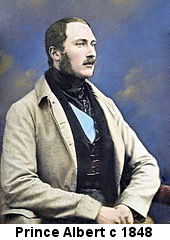 At least he was dry and reasonably comfortable. Back at Balloch the crowds were being soaked by regular showers. The other problem was that no one knew what was going on. By about six o’clock, people were getting restless and beginning to doubt that the Queen was coming because of the adverse weather. There was talk of dispersing the special constables which would have been taken as a sure signal that the visit was not going to happen. Just at that point, however, a horseman arrived with the news that although the Queen had stayed on the Royal Yacht, Prince Albert was now making his way down Loch Lomond on the Waterwitch.
At least he was dry and reasonably comfortable. Back at Balloch the crowds were being soaked by regular showers. The other problem was that no one knew what was going on. By about six o’clock, people were getting restless and beginning to doubt that the Queen was coming because of the adverse weather. There was talk of dispersing the special constables which would have been taken as a sure signal that the visit was not going to happen. Just at that point, however, a horseman arrived with the news that although the Queen had stayed on the Royal Yacht, Prince Albert was now making his way down Loch Lomond on the Waterwitch.
Just after that Sir James Campbell’s coach arrived to take up its position at the landing stage and one of the guns positioned in the park in front of Tullichewan Castle to fire a royal salute, fired the signal to let people know that the Waterwitch was in sight.
At about quarter to seven the Waterwitch reached the landing stage. Mr Campbell of Tullichewan, who was dressed in full Highland Regalia which was his favourite mode of dress, was immediately called on board and introduced to Prince Albert. His Royal Highness thanked Mr Campbell in the name of her Majesty for the handsome provisions he had made for the Royal party and expressed his regret that the weather had prevented her Majesty from visiting Loch Lomond.
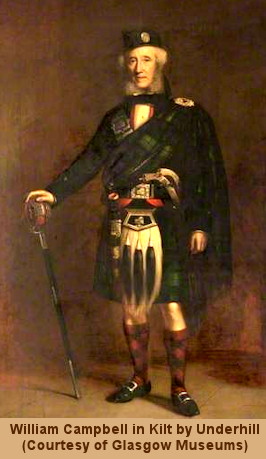 His Royal Highness was welcomed on shore by Sir James Colquhoun, Mr Smollett, Sheriff Colquhoun and other gentlemen and as he walked along the quay he acknowledged the applause with which he was greeted. The Glasgow Herald noted that “The landing platform was lined on either side by parties of ladies and gentlemen and as the weather had now cleared up and the shores and bridge were covered with people the effect of the whole was very pleasing. His Royal Highness with his equerry Colonel Anson and Sir James Clark, entered Sir James Colquhoun’s carriage and drove off amidst the most enthusiastic cheers. The Prince’s carriage was followed by 5 others.”
His Royal Highness was welcomed on shore by Sir James Colquhoun, Mr Smollett, Sheriff Colquhoun and other gentlemen and as he walked along the quay he acknowledged the applause with which he was greeted. The Glasgow Herald noted that “The landing platform was lined on either side by parties of ladies and gentlemen and as the weather had now cleared up and the shores and bridge were covered with people the effect of the whole was very pleasing. His Royal Highness with his equerry Colonel Anson and Sir James Clark, entered Sir James Colquhoun’s carriage and drove off amidst the most enthusiastic cheers. The Prince’s carriage was followed by 5 others.”
As a further mark of thanks to William Campbell, the royal carriages left the main road and entered the Tullichewan Castle driveway at the north lodge, passing round the park in front of the Castle, and out by the southern gate, where an arch of evergreens had been erected. A royal salute was fired from a battery in Tullichewan park.
To Dumbarton
All along the road from Balloch to Dumbarton everyone had their windows decorated with flowers in honour of the Royal visitors. Stands had been built at various points and the cheers which greeted Prince Albert “were almost as enthusiastic as could have been bestowed upon her majesty herself.”
The Queen and Prince Albert had visited Dumbarton 2 years previously, in 1847, but she had landed at the Castle and only visited the Castle. To the great disappointment of the people of Dumbarton she had not passed down the High Street, which was the area where most people lived. In 1847 Dumbartonians had decorated the centre of the town for the Queen but she didn’t come to see it. She didn’t come in 1849 either, but Prince Albert’s presence was enough and the old disappointment seemed to have been forgotten.
Dumbarton was similarly well decorated with flags of various descriptions flying from the church and other public buildings. Prince Albert reached Denny & Rankin’s wharf at about 7.30 and went on board HMY Fairy which had come up the Leven 2 hours earlier. A royal salute was fired from the Castle as he went on board as Dumbarton’s “great and good” lined the quay. The Fairy sailed down the Clyde to rejoin the rest of the Royal flotilla at their overnight moorings off Rosneath about 8.30pm. His whole trip had lasted about 5 hours.
Queen Victoria and Loch Lomond
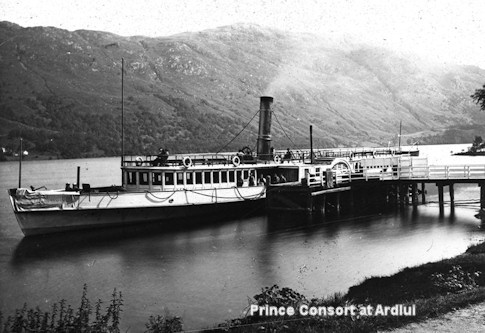 The Prince and Princess of Wales were the next Royal visitors to Loch Lomond when they sailed from Balloch to Inversnaid by steamer in 1864.
The Prince and Princess of Wales were the next Royal visitors to Loch Lomond when they sailed from Balloch to Inversnaid by steamer in 1864.
Queen Victoria never did manage to visit Loch Lomond with Prince Albert, who died in December 1861. So when the Queen did at last make it onto the Loch on 4th September 1869, when she took a cruise which started and ended at Inversnaid, she was already seven and a half years into her widowhood.
She was staying at Invertrossachs Lodge overlooking Loch Vennacher and to get to Inversnaid had sailed up Loch Katrine on the steamer Rob Roy and crossed by coach from Stronachlachar to Inversnaid. There she joined the steamer, The Pince Consort in which she made a circumnavigation of the Loch first sailing south on the east shore of the Loch down to Balloch and back up the west shore.
She was particularly impressed by the northern part of the Loch with its mountains and passes and the even higher mountains beyond. She was said to have been touched by the fact that the steamer on which she made her only Loch Lomond cruise was named The Prince Consort. It was, she wrote, “a most successful day”; “how dearest Albert would have enjoyed it”. That was doubtless true because unlike his sail in 1849, he would have been able to see the surrounding scenery.


